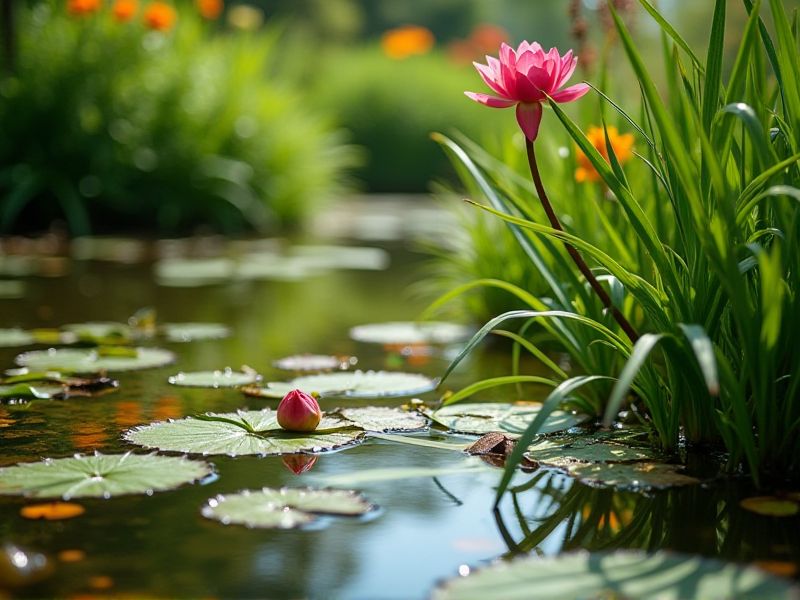
Incorporating native aquatic plants into your pond ecosystem can significantly enhance its overall health. Species like water lilies (Nymphaea) provide essential shade, helping to regulate water temperature and reduce the growth of algae. Cattails (Typha) act as natural filters, improving water clarity and providing habitat for wildlife. By introducing submerged plants like hornwort (Ceratophyllum demersum), you also increase oxygen levels, which are vital for fish and beneficial microorganisms. Maintaining a balanced mix of these plants not only promotes biodiversity but also helps manage nutrient levels, ensuring a thriving pond environment.
List of some Water plants that improve pond health
- Water Lily (Nymphaea)
- Water Hyacinth (Eichhornia crassipes)
- Cattail (Typha)
- Duckweed (Lemna)
- Water Lettuce (Pistia stratiotes)
- Hornwort (Ceratophyllum demersum)
- Pickerelweed (Pontederia cordata)
- Blue Flag Iris (Iris versicolor)
- Water Clover (Marsilea)
- Arrowhead (Sagittaria)
Important things about Water plants that improve pond health
Oxygenation Enhancement
Water plants such as hornwort, water hyacinth, and withered pond lily can significantly enhance oxygenation in ponds, promoting a balanced aquatic ecosystem. These plants naturally absorb carbon dioxide and release oxygen through photosynthesis, improving water quality and supporting fish and other wildlife. Incorporating water plants into your pond helps reduce algae growth by utilizing nutrients that would otherwise feed harmful organisms. Furthermore, oxygen-rich environments foster beneficial bacteria, which break down organic matter, contributing to overall pond health.
Algae Control
Incorporating specific water plants such as water lilies, hornwort, and cattails can significantly enhance pond health and aid in algae control. These aquatic plants provide essential shade, reducing sunlight penetration that fuels algae growth. Moreover, they absorb excess nutrients like nitrogen and phosphorus, which are primary contributors to algal blooms. By fostering a balanced ecosystem with these beneficial plants, you can create a healthier pond environment that supports diverse wildlife while minimizing the risk of algae proliferation.
Habitat Provision
Water plants such as Water Lilies (Nymphaea spp.) and Hornwort (Ceratophyllum demersum) play a crucial role in enhancing pond health by providing habitat and improving water quality. These aquatic plants offer shelter and breeding grounds for various organisms, including fish, amphibians, and beneficial microorganisms, fostering a diverse ecosystem. Furthermore, they help in reducing nutrient levels, mitigating algae blooms by absorbing excess nutrients like nitrogen and phosphorus, thus maintaining clear water conditions. For optimal pond health, consider incorporating a variety of native water plants that can adapt to your pond's specific conditions and support its ecological balance.
Nutrient Absorption
Water plants play a crucial role in enhancing nutrient absorption in ponds, contributing to overall aquatic health. Species such as water hyacinth and duckweed are effective in uptaking excess nutrients like nitrogen and phosphorus, which can lead to algal blooms when present in high concentrations. These plants also provide essential habitat for fish and beneficial microorganisms, supporting a balanced ecosystem. By incorporating suitable aquatic vegetation, you can improve water clarity and quality, promoting a thriving pond environment.
Sediment Stabilization
Water plants play a crucial role in enhancing pond health by stabilizing sediments and improving water quality. For instance, native aquatic plants such as cattails and bulrushes have extensive root systems that bind sediment, reducing erosion and preventing nutrient runoff. By absorbing excess nutrients like nitrogen and phosphorus, these plants help mitigate algal blooms, promoting a balanced aquatic ecosystem. Incorporating water plants in your pond not only supports aquatic biodiversity but also fosters a healthier habitat for fish and other wildlife.
Temperature Regulation
Water plants play a crucial role in regulating pond temperature, which is essential for maintaining a balanced ecosystem. Species such as water lilies and cattails provide shade, preventing excessive sunlight from warming the water and helping to maintain cooler temperatures for fish and aquatic life. By absorbing and filtering nutrients, these plants also enhance water quality, allowing for improved oxygen levels that support the overall health of the pond. For your pond, incorporating diverse aquatic vegetation can create a more stable thermal environment, benefiting both flora and fauna alike.
Pollutant Filtration
Water plants such as cattails, bulrushes, and water lilies play a crucial role in pollutant filtration, enhancing overall pond health. These aquatic plants absorb excess nutrients, like nitrogen and phosphorus, which can lead to algal blooms and degraded water quality. By stabilizing sediment and providing habitat for beneficial microorganisms, these plants promote biodiversity and maintain ecological balance within the pond ecosystem. Incorporating these plant species into your pond can significantly reduce pollutants while improving aesthetic appeal and water clarity.
Biodiversity Support
Water plants, such as water lilies and cattails, play a crucial role in enhancing pond health by providing habitat for aquatic organisms and improving water quality. These plants absorb excess nutrients, which reduces the risk of algae blooms and promotes a balanced ecosystem. The intricate root systems of submerged plants like hornwort serve as natural filtration, stabilizing sediments and preventing erosion. Incorporating native aquatic plants in your pond can significantly boost biodiversity, supporting a vibrant web of life that encompasses fish, amphibians, and various invertebrates.
Aesthetic Improvement
Incorporating water plants such as Water Lilies (Nymphaea) and Cattails (Typha) not only enhances the visual appeal of your pond but also significantly improves its ecosystem. These aquatic plants provide vital habitats for fish and beneficial microorganisms, fostering biodiversity and contributing to a balanced aquatic environment. Oxygenating plants like Hornwort (Ceratophyllum demersum) assist in maintaining water quality by absorbing excess nutrients and reducing algae growth. By selecting the right mix of water plants, you can create an aesthetically pleasing and ecologically healthy pond that thrives year-round.
Erosion Prevention
Water plants play a vital role in enhancing pond health and preventing erosion. Species such as cattails, bulrushes, and water lilies stabilize shorelines with their extensive root systems, reducing soil displacement caused by wind and water flow. These plants also improve water quality by absorbing excess nutrients and providing habitat for beneficial organisms. By incorporating these aquatic plants, you can create a thriving ecosystem that promotes biodiversity while safeguarding your pond's integrity.
